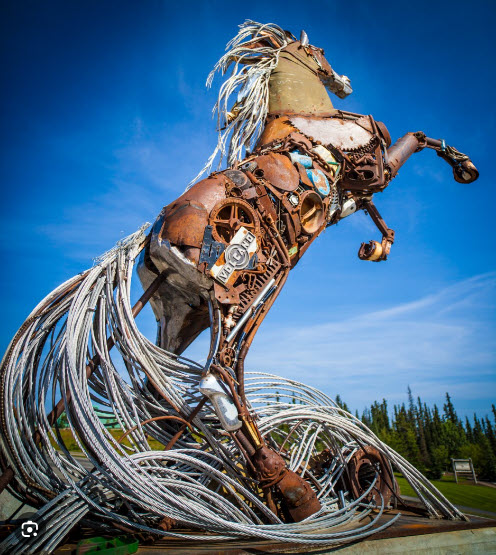The Power and Pride of a Unique Horse

Some years ago, my work took me to the Yukon for the first time. As we approached Whitehorse from the airport, I was surprised to see a stunning sculpture of a majestic and powerful horse rearing up on its hind legs on the hilltop overlooking the city.
Upon getting closer, it was even more interesting to see that the regal, almost 3.5-metre horse was cleverly composed of a compilation of scrap metal. Not just any scrap, but as I later learned, scrap made up of metal mementos donated by people throughout the Yukon Territory.
Contributions included baby spoons, a cast iron grill, iron spurs donated by relatives of an RCMP officer, a collection of wires donated by a utility company, tools, and even a piece of a thermometer that captured the coldest recorded temperature in the Yukon—a bone-chilling minus 81 degrees Fahrenheit (63 degrees Celsius).
Why a horse? Whitehorse got its name from the White Horse Rapids on the Yukon River, located near the present-day city. The rapids earned this name because the frothing water resembled the flowing manes of charging white horses. This poetic imagery inspired the naming of the settlement that would eventually become the capital of Yukon.
The sculpture was created when a new bylaw stated that all new City buildings must allocate one percent of construction costs toward a piece of public art. A call was issued for artist proposals.
Artist Daphne Mennell’s horse sculpture proposal stood out as unique. It was the only one that invited Yukon residents to be part of the creative process by donating metal objects that held personal significance for them. This inclusive approach made the community integral to the artwork’s creation, fostering a sense of ownership and pride. The horse has become a beloved local landmark representing the community and its connection to the broader Yukon territory.

Mennell’s irresistible idea resulted in a piece of public art that did what public art is supposed to do – increase public awareness and appreciation of the arts.
Public art is not as frivolous as some might think; instead, it can invigorate and enhance our public spaces, inspire imagination, make us believe, provide a sense of belonging, and transform where we live, work, and play. It can be several stories high or bring attention to the earth we walk on. It can inspire conversation, help us find tranquility amid stressful lifestyles, or even stimulate conversations due to controversy. This transformative power of public art can inspire us to see our surroundings in a new light.
Thriving communities have a clear brand and personality. Investing in developing a Municipal Public Art Policy that guides a public art program can be a crucial mechanism for making that more of a reality. When they are successful public art programs help communities develop and express their unique sense of place and character—their brand. This, in turn, can draw tourism and investment activity to the city. As such, it’s not a luxury; it’s a necessity.
Meaningful public art, like that of Whitehorse’s strong and charging horse, is a powerful tool for community development. It offers wide-ranging benefits that contribute to a neighbourhood or community’s social, economic, and cultural vitality.
The city of Welland, where I live, is developing a more comprehensive Public Art Policy. According to a recent Council Information Package, one objective is to “Develop a Public Art Policy to establish clear guidelines defining what qualifies as public art, as well as the process for approval and prescribes how the City will maintain public art.” This new policy is expected to be completed by the end of October 2024. The city is also reviewing its existing Municipal Arts and Culture Policy with the Arts and Culture Advisory Committee (ACAC).
Having initiated a willingness to revisit and potentially invest in a more substantial commitment to arts and culture and public art as an integral part of a community’s identity, Welland is on the right path.

Examples of the City of Welland Public Art
If your community doesn’t have a public art policy, you might want to suggest it as a priority. After all, art is language, and public art is public speech that can spark conversations and inspire the change needed for these challenging times.
Posted on 07-17-24Next entry: Sometimes Even Miracles Need New Strategies
Previous entry: Hard Work and Even Harder to Explain

 Brenda Herchmer is the owner of Grassroots Enterprises, a community development consulting company.
Brenda Herchmer is the owner of Grassroots Enterprises, a community development consulting company.